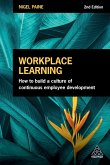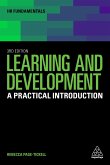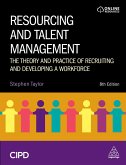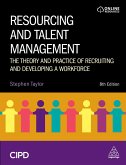Michael Armstrong
Armstrong's Handbook of Learning and Development
A Guide to the Theory and Practice of L&d
Michael Armstrong
Armstrong's Handbook of Learning and Development
A Guide to the Theory and Practice of L&d
- Gebundenes Buch
- Merkliste
- Auf die Merkliste
- Bewerten Bewerten
- Teilen
- Produkt teilen
- Produkterinnerung
- Produkterinnerung
Gain a complete understanding of the theory and practice of L&D for students and practitioners alike covering the fundamentals of learning and development, new developments, learning cultures and strategic L&D.
Andere Kunden interessierten sich auch für
![Armstrong's Handbook of Strategic Human Resource Management Armstrong's Handbook of Strategic Human Resource Management]() Michael ArmstrongArmstrong's Handbook of Strategic Human Resource Management138,99 €
Michael ArmstrongArmstrong's Handbook of Strategic Human Resource Management138,99 €![People Practice People Practice]() Karen WaitePeople Practice173,99 €
Karen WaitePeople Practice173,99 €![Workplace Learning Workplace Learning]() Nigel PaineWorkplace Learning108,99 €
Nigel PaineWorkplace Learning108,99 €![People Practice People Practice]() Karen WaitePeople Practice62,99 €
Karen WaitePeople Practice62,99 €![Learning and Development Learning and Development]() Rebecca Page-TickellLearning and Development20,99 €
Rebecca Page-TickellLearning and Development20,99 €![Resourcing and Talent Management Resourcing and Talent Management]() Stephen TaylorResourcing and Talent Management192,99 €
Stephen TaylorResourcing and Talent Management192,99 €![Resourcing and Talent Management Resourcing and Talent Management]() Stephen TaylorResourcing and Talent Management63,99 €
Stephen TaylorResourcing and Talent Management63,99 €-
-
-
Gain a complete understanding of the theory and practice of L&D for students and practitioners alike covering the fundamentals of learning and development, new developments, learning cultures and strategic L&D.
Produktdetails
- Produktdetails
- Verlag: Kogan Page
- Seitenzahl: 344
- Erscheinungstermin: 30. November 2021
- Englisch
- Abmessung: 250mm x 175mm x 27mm
- Gewicht: 1059g
- ISBN-13: 9781398601901
- ISBN-10: 139860190X
- Artikelnr.: 60904259
- Herstellerkennzeichnung
- Libri GmbH
- Europaallee 1
- 36244 Bad Hersfeld
- gpsr@libri.de
- Verlag: Kogan Page
- Seitenzahl: 344
- Erscheinungstermin: 30. November 2021
- Englisch
- Abmessung: 250mm x 175mm x 27mm
- Gewicht: 1059g
- ISBN-13: 9781398601901
- ISBN-10: 139860190X
- Artikelnr.: 60904259
- Herstellerkennzeichnung
- Libri GmbH
- Europaallee 1
- 36244 Bad Hersfeld
- gpsr@libri.de
Michael Armstrong is the UK's bestselling author of Human Resource Management books including Armstrong's Handbook of Human Resource Management Practice, Armstrong's Handbook of Strategic Human Resource Management, Armstrong's Handbook of Reward Management Practice and Armstrong's Handbook of Performance Management and several other titles published by Kogan Page. His books have sold over a million copies and have been translated into twenty-one languages. Michael Armstrong is a Companion and former Chief Examiner of the Chartered Institute of Personnel and Development (CIPD), a managing partner of E-Reward and an independent management consultant. Prior to this he was an HR director of a publishing company. He is based in London, UK.
Chapter
00: Introduction; Section
ONE: Fundamentals of learning and development; Chapter
01: The basis of learning and development; Chapter
02: The context of learning and development; Chapter
03: Learning culture; Chapter
04: Organizational learning and the learning organization; Chapter
05: Individual learning; Chapter
06: Learning and development strategy; Chapter
07: The contribution of learning and development to organizational performance; Chapter
08: Learning analytics; Section
TWO: The responsibility for learning and development; Chapter
09: The role of the learning and development function; Chapter
10: The role of the line manager; Section
THREE: The process of learning; Chapter
11: The nature of learning; Chapter
12: Approaches to learning and development; Chapter
13: Learning and development techniques; Section
FOUR: Areas of learning; Chapter
14: Workplace learning; Chapter
15: Social learning; Chapter
16: Digital learning; Chapter
17: Training; Section
FIVE: Planning and delivering learning events; Chapter
18: Identifying learning needs; Chapter
19: Planning learning events; Chapter
20: Managing learning events; Chapter
21: Transferring learning; Chapter
22: Evaluating learning events; Section
SIX: Aspects of learning and development; Chapter
23: Leadership and management development; Chapter
24: Sales training; Chapter
25: Apprenticeships; Section
SEVEN: Conclusion; Chapter
26: Learning and development trends and issues
00: Introduction; Section
ONE: Fundamentals of learning and development; Chapter
01: The basis of learning and development; Chapter
02: The context of learning and development; Chapter
03: Learning culture; Chapter
04: Organizational learning and the learning organization; Chapter
05: Individual learning; Chapter
06: Learning and development strategy; Chapter
07: The contribution of learning and development to organizational performance; Chapter
08: Learning analytics; Section
TWO: The responsibility for learning and development; Chapter
09: The role of the learning and development function; Chapter
10: The role of the line manager; Section
THREE: The process of learning; Chapter
11: The nature of learning; Chapter
12: Approaches to learning and development; Chapter
13: Learning and development techniques; Section
FOUR: Areas of learning; Chapter
14: Workplace learning; Chapter
15: Social learning; Chapter
16: Digital learning; Chapter
17: Training; Section
FIVE: Planning and delivering learning events; Chapter
18: Identifying learning needs; Chapter
19: Planning learning events; Chapter
20: Managing learning events; Chapter
21: Transferring learning; Chapter
22: Evaluating learning events; Section
SIX: Aspects of learning and development; Chapter
23: Leadership and management development; Chapter
24: Sales training; Chapter
25: Apprenticeships; Section
SEVEN: Conclusion; Chapter
26: Learning and development trends and issues
- Chapter - 00: Introduction;
- Section - ONE: Fundamentals of learning and development;
- Chapter - 01: The basis of learning and development;
- Chapter - 02: The context of learning and development;
- Chapter - 03: Learning culture;
- Chapter - 04: Organizational learning and the learning organization;
- Chapter - 05: Individual learning;
- Chapter - 06: Learning and development strategy;
- Chapter - 07: The contribution of learning and development to organizational performance;
- Chapter - 08: Learning analytics;
- Section - TWO: The responsibility for learning and development;
- Chapter - 09: The role of the learning and development function;
- Chapter - 10: The role of the line manager;
- Section - THREE: The process of learning;
- Chapter - 11: The nature of learning;
- Chapter - 12: Approaches to learning and development;
- Chapter - 13: Learning and development techniques;
- Section - FOUR: Areas of learning;
- Chapter - 14: Workplace learning;
- Chapter - 15: Social learning;
- Chapter - 16: Digital learning;
- Chapter - 17: Training;
- Section - FIVE: Planning and delivering learning events;
- Chapter - 18: Identifying learning needs;
- Chapter - 19: Planning learning events;
- Chapter - 20: Managing learning events;
- Chapter - 21: Transferring learning;
- Chapter - 22: Evaluating learning events;
- Section - SIX: Aspects of learning and development;
- Chapter - 23: Leadership and management development;
- Chapter - 24: Sales training;
- Chapter - 25: Apprenticeships;
- Section - SEVEN: Conclusion;
- Chapter - 26: Learning and development trends and issues
Chapter
00: Introduction; Section
ONE: Fundamentals of learning and development; Chapter
01: The basis of learning and development; Chapter
02: The context of learning and development; Chapter
03: Learning culture; Chapter
04: Organizational learning and the learning organization; Chapter
05: Individual learning; Chapter
06: Learning and development strategy; Chapter
07: The contribution of learning and development to organizational performance; Chapter
08: Learning analytics; Section
TWO: The responsibility for learning and development; Chapter
09: The role of the learning and development function; Chapter
10: The role of the line manager; Section
THREE: The process of learning; Chapter
11: The nature of learning; Chapter
12: Approaches to learning and development; Chapter
13: Learning and development techniques; Section
FOUR: Areas of learning; Chapter
14: Workplace learning; Chapter
15: Social learning; Chapter
16: Digital learning; Chapter
17: Training; Section
FIVE: Planning and delivering learning events; Chapter
18: Identifying learning needs; Chapter
19: Planning learning events; Chapter
20: Managing learning events; Chapter
21: Transferring learning; Chapter
22: Evaluating learning events; Section
SIX: Aspects of learning and development; Chapter
23: Leadership and management development; Chapter
24: Sales training; Chapter
25: Apprenticeships; Section
SEVEN: Conclusion; Chapter
26: Learning and development trends and issues
00: Introduction; Section
ONE: Fundamentals of learning and development; Chapter
01: The basis of learning and development; Chapter
02: The context of learning and development; Chapter
03: Learning culture; Chapter
04: Organizational learning and the learning organization; Chapter
05: Individual learning; Chapter
06: Learning and development strategy; Chapter
07: The contribution of learning and development to organizational performance; Chapter
08: Learning analytics; Section
TWO: The responsibility for learning and development; Chapter
09: The role of the learning and development function; Chapter
10: The role of the line manager; Section
THREE: The process of learning; Chapter
11: The nature of learning; Chapter
12: Approaches to learning and development; Chapter
13: Learning and development techniques; Section
FOUR: Areas of learning; Chapter
14: Workplace learning; Chapter
15: Social learning; Chapter
16: Digital learning; Chapter
17: Training; Section
FIVE: Planning and delivering learning events; Chapter
18: Identifying learning needs; Chapter
19: Planning learning events; Chapter
20: Managing learning events; Chapter
21: Transferring learning; Chapter
22: Evaluating learning events; Section
SIX: Aspects of learning and development; Chapter
23: Leadership and management development; Chapter
24: Sales training; Chapter
25: Apprenticeships; Section
SEVEN: Conclusion; Chapter
26: Learning and development trends and issues
- Chapter - 00: Introduction;
- Section - ONE: Fundamentals of learning and development;
- Chapter - 01: The basis of learning and development;
- Chapter - 02: The context of learning and development;
- Chapter - 03: Learning culture;
- Chapter - 04: Organizational learning and the learning organization;
- Chapter - 05: Individual learning;
- Chapter - 06: Learning and development strategy;
- Chapter - 07: The contribution of learning and development to organizational performance;
- Chapter - 08: Learning analytics;
- Section - TWO: The responsibility for learning and development;
- Chapter - 09: The role of the learning and development function;
- Chapter - 10: The role of the line manager;
- Section - THREE: The process of learning;
- Chapter - 11: The nature of learning;
- Chapter - 12: Approaches to learning and development;
- Chapter - 13: Learning and development techniques;
- Section - FOUR: Areas of learning;
- Chapter - 14: Workplace learning;
- Chapter - 15: Social learning;
- Chapter - 16: Digital learning;
- Chapter - 17: Training;
- Section - FIVE: Planning and delivering learning events;
- Chapter - 18: Identifying learning needs;
- Chapter - 19: Planning learning events;
- Chapter - 20: Managing learning events;
- Chapter - 21: Transferring learning;
- Chapter - 22: Evaluating learning events;
- Section - SIX: Aspects of learning and development;
- Chapter - 23: Leadership and management development;
- Chapter - 24: Sales training;
- Chapter - 25: Apprenticeships;
- Section - SEVEN: Conclusion;
- Chapter - 26: Learning and development trends and issues
"This book is both thought-provoking and academically astute; it explores various emerging areas within learning and development concisely and clearly. Armstrong is able to bring theory to life, helping readers to develop their own understanding of critical HR practice." Rebecca Huws, Human Resources Lecture/ CIPD Programme Lead, Cardiff and Vale College








